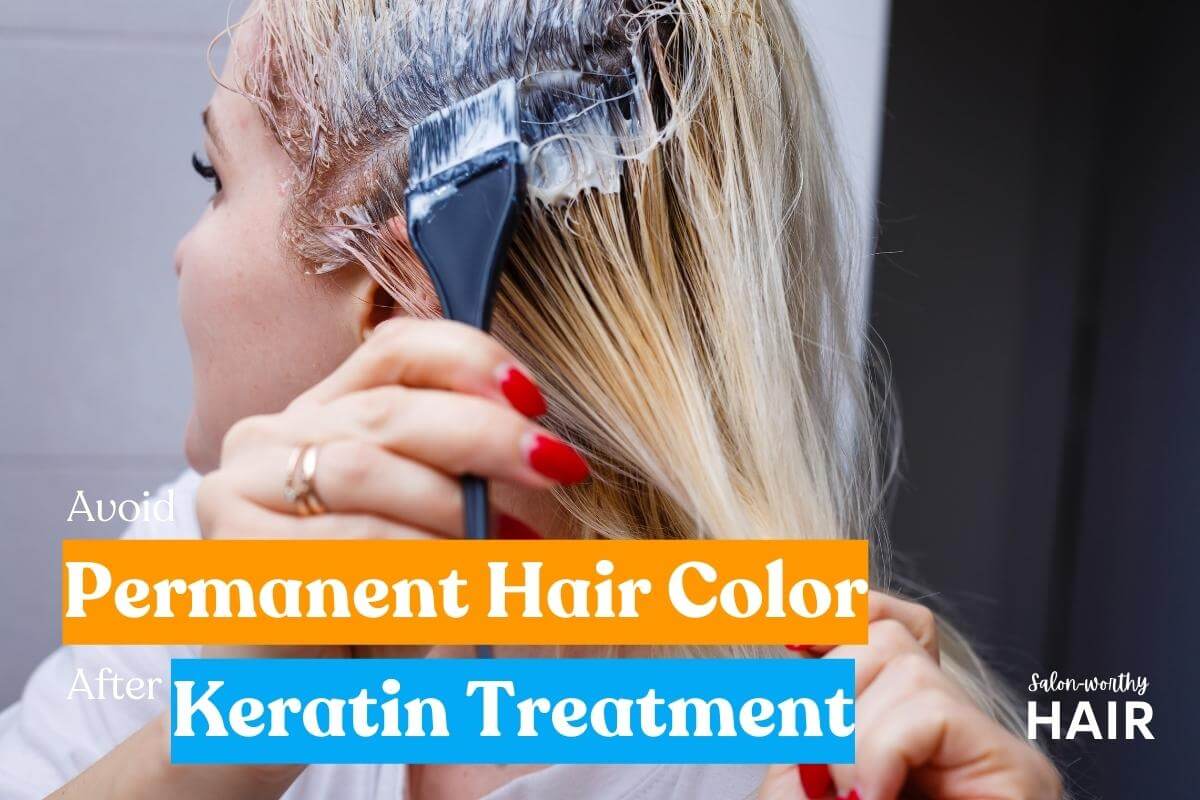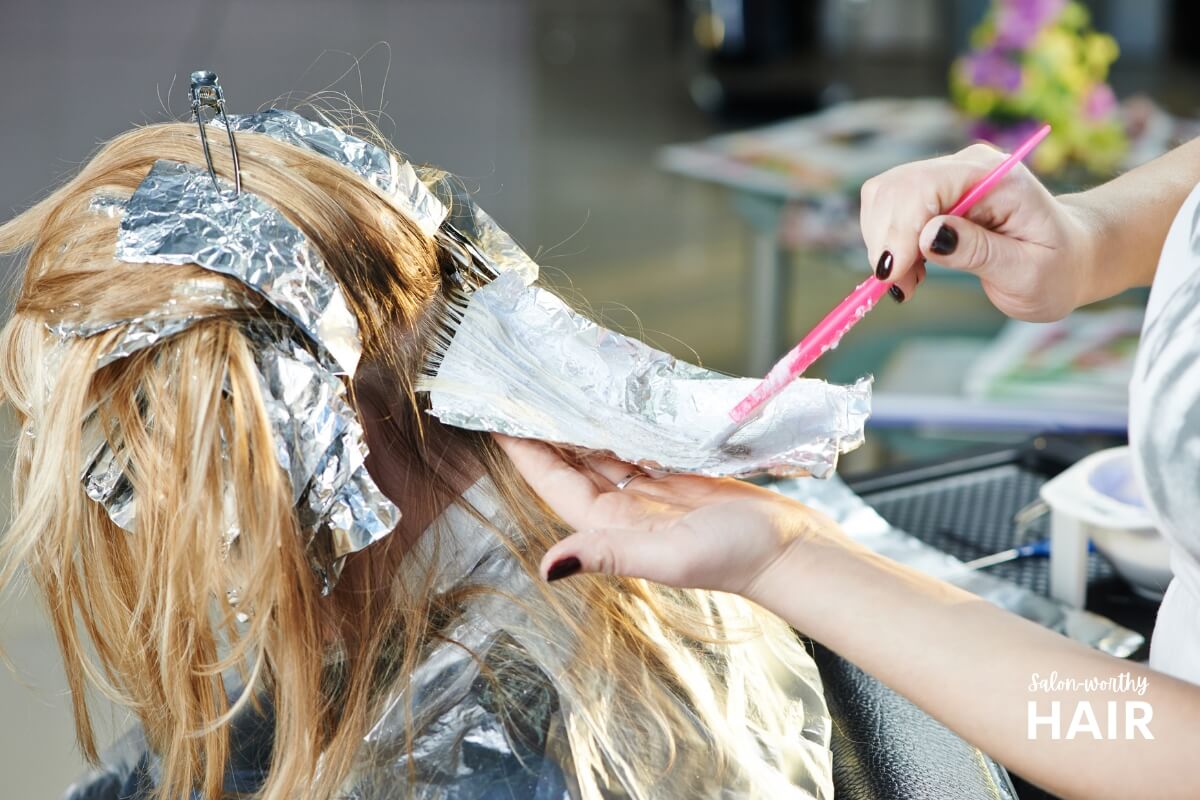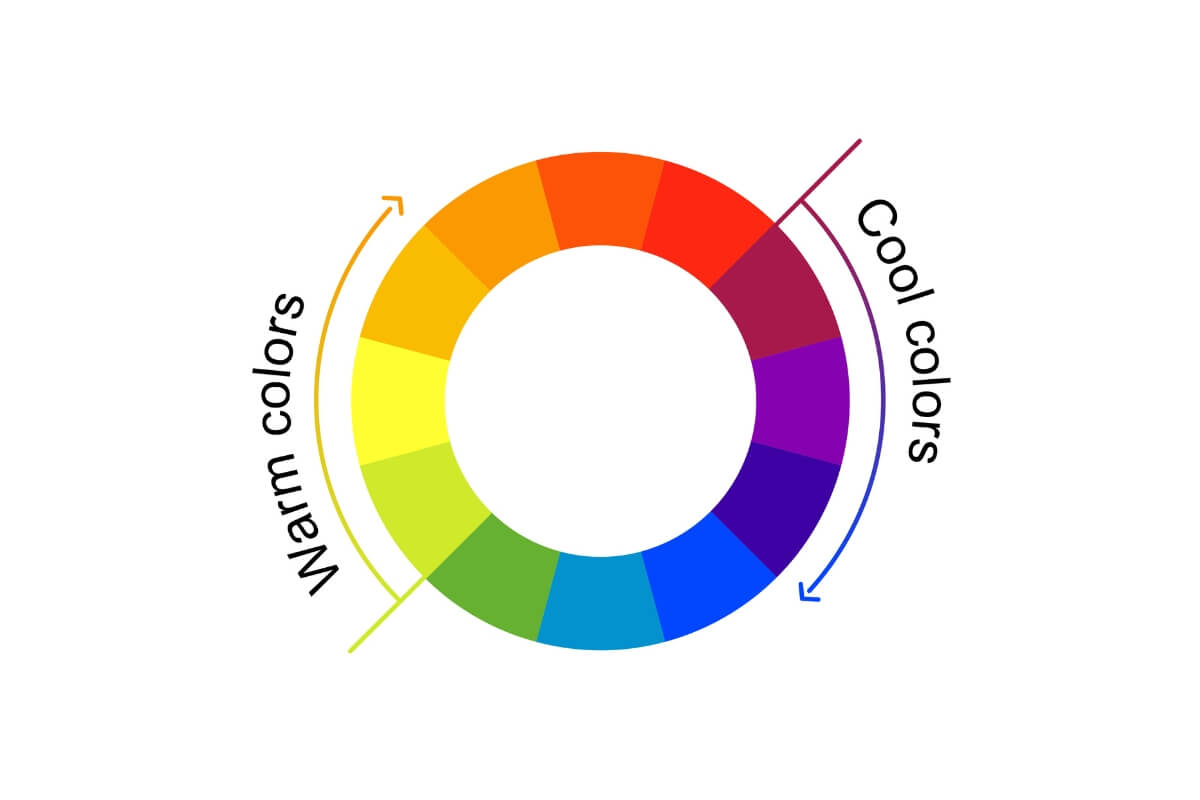How Soon Can You Color Your Hair After Keratin Treatment?
Updated on
This post may contain affiliate links. As an Amazon Associate, we may earn from qualifying purchases.

Hair coloring and keratin treatment are two popular salon treatments that can alter the color and texture of your hair.
Hair coloring involves applying dye chemicals to the hair shaft to change its color, either permanently with oxidative dyes or semi-permanently with direct dyes. Hair coloring can help you make your hair color darker, lighter, cover gray hairs, add more dimension to your hair style via highlights and lowlights, or achieve fashionable shades like reds, blues, and purples.
Keratin treatment is a semi-permanent hair straightening or smoothing treatment. Stronger products like the Brazilian straightening use Formaldehyde or its derivates to straighten the hair. Keratin treatment can be performed on all hair types to partially eliminate frizz, straighten curls and waves, and make the hair smoother and more manageable for up to 3 months.
While hair coloring and keratin treatments work differently, they both rely on chemical reactions with the hair shaft to alter its appearance, color, or texture.
This brings us to a common dilemma:
Should you get a keratin treatment before or after hair coloring?
The sequence in which you opt for these treatments can affect the longevity, effectiveness of your keratin treatment, and overall health and appearance of your hair. Making the right choice requires a thorough understanding of each method’s underlying processes and potential outcomes.
In this article, I will cover the pros and cons of each sequence, delve into the science behind these treatments, and help you make an informed decision on how to approach keratin treatment and hair coloring most effectively.
Table of Contents
- Can You Dye Your Hair After a Keratin Treatment?
- Why You Must Wait 2 Weeks to Color Keratin Treated Hair?
- What Happens When You Color Your Hair Too Soon After Keratin Treatment?
- Precautions When Dyeing Hair After Keratin Treatment
- Can You Straighten Keratin Treated Hair After Dyeing It?
- Can You Use Permanent Hair Color After Keratin Treatment?
- Can You Bleach Hair After Keratin Treatment?
- Can You Use Toner After Keratin Treatment?
- Can You Do Highlights After Keratin Treatment?
- How to Cover Gray Hair After Keratin Treatment
- How to Do Root Touch-Up After Keratin Treatment
- Can You Apply Henna on Keratin Treated Hair?
- Can You Color Hair Before Keratin Treatment?
- Fancy Coloring Your Hair After Keratin Treatment?
Can You Dye Your Hair After a Keratin Treatment?
You can dye your hair 2 weeks (14 days) after a keratin treatment, including Brazilian straightening, smoothing, and protein treatments. You must not color, tone, highlight, or bleach your hair immediately after the treatment.
After consulting with a professional hairstylist at the Aveda Lifestyle Salon in London, I was advised that dyeing my hair within the first 2 weeks after keratin is applied could significantly reduce the effectiveness and longevity of the treatment.

Chemicals used in hair dyes can interfere with the keratin’s bonding process to the hair shaft, potentially leading to uneven color results and a compromised keratin seal.
Furthermore, the hairstylist emphasized that hair becomes more porous after dyeing, resulting in a faster fade of the color if done immediately post-keratin treatment. When given the full 2 weeks to bond and set properly, the keratin coating acts as a protective layer, ensuring the hair dye lasts longer and retains its vibrancy.
Why You Must Wait 2 Weeks to Color Keratin Treated Hair?
Applying hair dye to a freshly done keratin treatment can increase hair dryness, brittleness, and even breakage. The hair might also feel weighed down or excessively oily, resulting in a less-than-desirable look and feel.
Waiting for the recommended 2-week period ensures that the keratin treatment has fully bonded to the hair shaft, providing a stable foundation for the coloring process. This waiting period allows the hair to regain its natural pH balance and properly seal the hair cuticles.
When keratin treatments and hair dyes are applied in close succession, they can harm hair health. The chemicals in the dye can react with the keratin, potentially weakening the hair structure and leading to color inconsistencies. Hairdressers emphasize giving each treatment time to settle and deliver the desired results.
How Long Should You Wait Between Coloring Sessions?
Subsequent hair coloring sessions must be done in 4 to 6 weeks.
The 4 to 6 weeks timeframe allows:
- Hair Recovery: It gives your hair ample time to recover from the chemical processes involved in the previous coloring.
- Visible Root Growth: Waiting 4-6 weeks results in enough root growth for a touch-up, especially if you cover grays or maintain a color significantly different from your natural hue.
- Color Longevity: Most hair dyes last for about 4-6 weeks before fading becomes noticeable, especially with regular shampooing.
However, it is important to note that the exact duration can vary based on:
- Hair Type and Health: Damaged hair may require longer intervals between coloring to avoid further damage, while healthy hair may be able to handle more frequent coloring.
- Type of Hair Dye: Semi-permanent dyes fade faster and may need reapplication every 2-3 weeks, while permanent dyes last longer.
- Desired Results: If you are going for a drastic change, like going from dark to blonde, it may require more frequent sessions initially.
Always consult your hairdresser to determine the best schedule for your hair type and hair color goals.
What Happens When You Color Your Hair Too Soon After Keratin Treatment?
If you color your hair too soon after a keratin treatment, you may risk reducing the effectiveness of your keratin treatment. As a result, you may end up with patchy hair colors, trigger hair damage, and experience potential chemical reactions.
- Reduced Effectiveness of Keratin Treatment: Hair coloring involves chemical processes that can potentially strip away some of the applied keratin from the hair. The compromised keratin coating means you will not benefit from the treatment, such as hair smoothness, straightness, and frizz control.
- Uneven Color Absorption: Keratin treated hair initially has a sealed cuticle. Applying hair dye during this period can result in uneven color absorption, leading to patchy or inconsistent color results.
- Rapid Color Fading: Since the keratin treatment seals the hair cuticle, applying dye immediately after will not allow the color to penetrate deeply. This surface-level dye is more prone to washing out quickly, leading to faster color fading.
- Potential Hair Damage: Both keratin treatments and hair coloring involve altering the hair’s structure using chemicals. Doing them in quick succession can stress the hair, making it more vulnerable to dryness, breakage, and damage.
- Increased Hair Porosity: Coloring can increase the porosity of the hair, which means the hair may lose some of the benefits of the keratin treatment, like moisture retention and reduced frizz.
- Chemical Reactions: Hair dyes and the chemicals used in keratin treatments may react adversely when applied close together. This overlap can lead to unexpected changes in hair color or texture.
Waiting 2 weeks between a keratin treatment and hair coloring to avoid these potential issues is always recommended. The settling period ensures both treatments can work effectively without interfering with each other.
Precautions When Dyeing Hair After Keratin Treatment
When dyeing hair after a keratin treatment, it is essential to follow certain precautions to ensure the best results and maintain the integrity of both treatments. Here are some precautions to consider:
- Wait for the Recommended Time: The recommended waiting period ensures that the keratin has fully bonded to the hair shaft.
- Use Sulfate-Free and Ammonia-Free Hair Dyes: Sulfates and Ammonia open up the hair cuticle to allow the dye to penetrate. After a keratin treatment, the goal is to keep the cuticle sealed to lock in the benefits of the treatment. Using Sulfate-free and Ammonia-free dyes ensures that the hair cuticle remains undisturbed, preserving the keratin treatment results.
- Avoid High-lift Colors Initially: High-lift colors or bleach can be more aggressive on the hair. If you plan on significantly lightening your hair, consult your stylist about the best approach post-keratin.
- Patch Test: Before fully coloring your hair, consider doing a patch test to see how your hair reacts to the dye post-keratin treatment. Patch testing can help you avoid unexpected results on your entire head of hair.
- Consult a Professional: It’s always a good idea to consult a trusted hairstylist who understands the intricacies of working with colored and keratin treated hair.
- Limit Heat Styling: Both the coloring and keratin treatment process the hair. Limit the use of heat styling tools immediately after dyeing to reduce the chances of damage.
Can You Straighten Keratin Treated Hair After Dyeing It?
Yes, you can straighten keratin treated hair after dyeing it, but there are some precautions and guidelines you should follow:
- Wait for the Dye to Settle: After dyeing your hair, it’s advisable to wait at least 48-72 hours before using heat styling tools, including straighteners. The waiting period allows the color to set in and minimizes the risk of color fading due to heat.
- Use a Heat Protectant: Before straightening, always apply a heat protectant to your hair. This product forms a protective barrier, minimizing potential heat damage and reducing the risk of color fading.
- Opt for Lower Temperatures: Keratin treated hair is more manageable and easily straightens. Therefore, you will not need the highest temperature setting on your straightener. Using a lower temperature reduces the risk of heat damage and helps preserve both the keratin treatment’s color and benefits.
- Limit Frequency: Try to limit the frequency of straightening. Overusing heat tools can lead to increased dryness and damage, even on keratin treated hair.
Can You Use Permanent Hair Color After Keratin Treatment?
Do not use permanent hair dyes on keratin treated hair because they contain ammonia or an ammonia substitute. Permanent hair dyes penetrate deep into the hair’s cortex by lifting the cuticle, the hair’s outer protective layer.

By opening the cuticle, ammonia allows the color to enter and react with the hair’s natural pigment. This process results in a long-lasting hair color change that is resistant to washing out.
Given that keratin treatments aim to seal the cuticle and smooth the hair, using an aggressive dye that opens the cuticle afterward can counteract some of the benefits of the keratin treatment. It might reduce the keratin treatment’s smoothness, shine, and longevity. A permanent hair dye may also prematurely strip the keratin coating from your hair.
Can You Bleach Hair After Keratin Treatment?
Do not bleach your hair immediately after a keratin treatment or Brazilian blowout. Bleaching hair immediately post-treatment can be harmful due to chemical interactions, especially if the keratin treatment contains high Formaldehyde levels, like in a Brazilian Blowout.

Hair bleaching is a cosmetic procedure for lightening hair color using bleaching agents such as hydrogen peroxides and persulfate salts. Hair bleaching can also be done with a hair toner to enhance the hair coloring process, add highlights to hair, or go from dark hair to lighter colors like blonde.
At the core of hair bleaching is the chemical reaction facilitated by the active bleaching agents that lift the hair’s cuticles to reach the cortex, where the melanin resides. The high lift of the hair cuticles can be problematic for keratin treated hair. Keratin treatments infuse the hair with proteins, often sealing the cuticle to provide a smoother, frizz-free appearance. Bleaching post-keratin treatment can disrupt this sealed cuticle, stripping away the recently added proteins and diminishing the benefits of the keratin treatment.
If you want to lighten your hair color after a keratin treatment, Wella, a global haircare brand, offers a no-bleach lightening option: Wella’s Professional Koleston Perfect. Briana Cisneros,
Consult a knowledgeable hairstylist before any bleaching or coloring post-keratin. They can evaluate your hair’s condition and advise on safe procedures, ensuring no additional strain is placed on fragile strands.
Can You Use Toner After Keratin Treatment?
Yes, you can use toner 2 weeks after your keratin treatment. Toner often contains mild peroxides or other chemicals that can potentially affect the results of the keratin treatment.
A toner is a hair product that adjusts the tone of bleached or pre-lightened hair. It neutralizes unwanted brassy or yellow tones to achieve a desired shade of blonde, silver, or pastel. Unlike hair dyes that add color, toner adjusts the tone of the hair. It can enhance or diminish certain hues, ensuring the final result is closer to the desired shade.

Hair toner can either have an ammonia base (which opens up the hair cuticle slightly to adjust the color) or an acidic base (which closes the cuticle and adds shine). Some toners, especially those with an ammonia base, might interact with the keratin treatment, leading to reduced longevity of the treatment or changes in hair color.
Can You Do Highlights After Keratin Treatment?
You can do hair highlights 2 weeks after your keratin treatment or Brazilian Blowout. Almost all hair-highlighting processes involve bleach or a lightening agent, which typically contains Hydrogen Peroxide or Ammonia. While Ammonia can be harsh, it’s not always strictly avoided after keratin treatments. The primary concern is the lightening process, which can be more damaging to the hair, especially when combined with a recent keratin treatment.
Hair highlighting is a hair coloring technique that selectively lightens or colors specific hair strands to create dimension and contrast. Hair highlighting adds depth and texture to your hair color by targeting individual sections rather than the entire head. It also offers varied multi-tonal appearances to amplify your hair’s natural tones or introduce new hues, allowing for personalized customization.
The problem with hair highlighting is the process involved, such as applying a lightening agent or hair dye in subsections of your hair, foil wrapping, and toning. The foil wrapping, used to isolate and intensify the color processing, can generate heat that further challenges the integrity of the keratin treatment. Toning is often employed to achieve the desired shade and neutralize unwanted tones. This additional chemical process can further strip away the benefits of the keratin treatment.
Thus, it is imperative to approach highlighting with caution after a keratin treatment and to consult with a professional to ensure the health and beauty of the hair are maintained.
Can You Do Lowlights After Keratin Treatment?
You can do lowlights two weeks after a Brazilian keratin treatment.
Unlike highlights, lowlights add depth and richness to selected sections of hair rather than removing color pigments to lighten. Lowlights can provide a multi-dimensional look, giving the hair a more textured, layered appearance. They’re particularly effective in enhancing volume and breaking up overly lightened or monochromatic shades.
Lowlighting in hair is typically done using a permanent or semi-permanent dye, which deposits color into the hair shaft. It’s a method of reintroducing darker tones, often lost through natural light from the sun or repeated highlighting procedures.
Lowlights on keratin treated hair can be considered more favorable than highlights because the process involves depositing color to darken selected strands or cover gray hair, typically a gentler process than removing color. Unlike highlights, lowlights do not require aggressive lightening chemicals like bleach. Therefore, lowlights are less likely to compromise the benefits of a recent keratin treatment.
How to Cover Gray Hair After Keratin Treatment
To safely cover gray hair after a keratin treatment, wait 2 weeks first, use an Ammonia-free hair dye, and strictly use a sulfate-free shampoo to wash the hair dye after it has processed. If only your roots are gray, consider a root touch-up instead of covering your entire head.
Here are the step-by-step instructions to safely cover gray hair after a keratin treatment:
- Wait for the right time: I must emphasize waiting 2 weeks after your keratin treatment to color your hair.
- Choose Ammonia-Free Dyes: Ammonia-free dyes are gentler and less likely to strip the hair of the keratin treatment.
- Root Touch-Up: If only the roots are gray, consider a root touch-up instead of coloring the entire head. This method focuses solely on the gray areas, reducing overall chemical exposure to the hair.
- Lowlights: If you’re looking for a more natural approach and don’t have a significant amount of grays, consider adding lowlights. Lowlights can blend and camouflage the grays by adding depth and dimension to the hair.
- Use Color-Safe Shampoos and Conditioners: To maintain the color and the benefits of the keratin treatment, use shampoos and conditioners formulated for color-treated hair. These products are typically sulfate-free and recommended for hair with a keratin treatment.
- Avoid Frequent Washing: Try to reduce the frequency of hair washing to preserve the color and extend the longevity of the keratin treatment.
The best product to cover gray hair after keratin treatment is the Clairol Beautiful Collection Semi-Permanent Hair Color. It is easy to apply, processed in 25 minutes and lasts up to 8 washes.
How to Do Root Touch-Up After Keratin Treatment
Doing a root touch-up after a keratin treatment can help maintain a cohesive hair color while preserving the benefits of the treatment.
A root touch-up is a hair coloring technique targeting the regrowth area near the scalp rather than the entire hair length. This process ensures the roots match the rest of the hair color, giving a consistent look, especially for those with noticeable color differences between natural and dyed hair. As hair grows, the untreated roots start to show, revealing either the original hair color or grays. The root touch-up method involves carefully applying color only to this new growth, ensuring a seamless blend with the previously colored strands.
Here is a step-by-step guide on how to approach a root touch-up on keratin treated hair:
Products you’ll need:
Instructions:
- Section your hair: Begin by dividing your hair into four main sections: front left, front right, back left, and back right. Secure each section with a clip. Sectioning ensures even application and helps you manage your hair more easily.
- Application: Start with the section where gray or inconsistent hair colors are most prominent or where the regrowth is most noticeable. Apply the color using a brush, ensuring only the roots/gray areas are covered to avoid overlapping onto previously colored hair.
- Processing: Allow the color to process according to the manufacturer’s instructions. It’s essential not to leave the color on longer than recommended, as it can lead to over-darkening or unwanted tones.
Tips and Precautions:
- Wait Before Coloring: Follow the keratin treatment aftercare guidance and wait until it’s safe to color your hair again. 2 weeks is the recommended waiting period.
- Avoid Overlapping: Be precise with your application. Overlapping the new color with previously colored hair can lead to uneven color.
- Use Protective Gear: Wear gloves to protect your hands from staining, and use a cape or old towel to shield your clothes.
- Aftercare: Rinse the color thoroughly until the water runs clear. Use a sulfate-free, color-safe shampoo and conditioner to maintain the color and the keratin treatment.
Can You Apply Henna on Keratin Treated Hair?
Applying henna to keratin treated hair is not recommended because henna might not bind as effectively to keratin treated hair. The application can result in a lighter or less intense color because the hair shaft is smoother and less porous after the treatment.
Pure henna, a natural hair dye derived from the Lawsonia Inermis plant, doesn’t generally have adverse reactions with keratin treatments. However, some commercial “henna” products might contain metallic salts or other additives that can react with the residue from the keratin treatment.
Can You Color Hair Before Keratin Treatment?
Yes, you can color your hair before a keratin treatment. It is recommended to color your hair first if you’re considering both treatments.
Coloring your hair can lift its cuticle slightly, making it more receptive to the keratin treatment. When the hair cuticle is lifted, the keratin molecules can penetrate deeper into the hair shaft, leading to better and longer-lasting results.
If you get a keratin treatment before coloring, sealing the hair with keratin might cause the color to fade or change slightly. Coloring first ensures the hair color is locked in before applying the keratin.

Read more: Why You Should Color Your Hair Before a Keratin Treatment.
How Soon After Coloring Hair Can You Do Keratin Treatment?
A keratin treatment can be done immediately, on the same day, and in the same session after coloring or bleaching, as long as a professional hairdresser performs it.
Combining the processes can be very convenient if you have a tight schedule or don’t want to make multiple trips to the salon. Keratin products on the market are specifically formulated to be used immediately after a chemical process. These products often have a milder formulation and can be more hydrating, ensuring that the hair doesn’t undergo too much stress.
The process of doing them back-to-back has some rationale and benefits:
- Immediate Damage Control: Bleaching and coloring can be particularly harsh on the hair, causing damage and porosity. A keratin treatment can immediately address this damage by filling the porous areas, sealing the hair shaft, and providing a protective barrier.
- Efficiency and convenience: It saves multiple trips to the hair salon.
- Enhanced Results: The raised cuticles from the coloring or bleaching process can allow for better keratin absorption, potentially leading to more effective results.
- Potential for Color Alteration: There’s a slight risk that the keratin treatment can alter the fresh color, especially if it requires locking in the product with a flat iron. The heat might cause subtle changes in the hair color.
- Professional Expertise: The success of doing both treatments in one session largely depends on the expertise of the professional handling your hair. They must be well-versed in both processes and understand how different products interact.
However, not all hair types or conditions can withstand back-to-back chemical treatments. If your hair is already compromised or particularly fragile, it may be best to wait. That’s why it is better to get these treatments done by a professional hairdresser who can assess your hair at each stage and advise accordingly.
Many salons offer the option to get a keratin treatment immediately after coloring or bleaching; ensuring the process is tailored to your hair needs and condition is crucial. Always rely on a trusted and experienced professional for guidance.
What Are the Best Hair Dyes for Keratin Treated Hair?
The best hair dyes for keratin treated hair are semi-permanent, non-stripping, ammonia-free, peroxide-free, and sulfate-free. These hair dyes do not create high lift and are designed not to disrupt the hair’s cuticle layer, therefore maintaining the integrity of your keratin treatment.
Some of the best hair dyes for use after keratin treatment include Keracolor Clenditioner, Clairol Natural Instincts, and Madison Reed.
Fancy Coloring Your Hair After Keratin Treatment?
To get the best of both worlds, wait two weeks after your keratin treatment to add color to your hair. Whether you’re considering lightening your hair, adding highlights, lowlights, balayage, toning your existing color, covering your gray hair, or touching up your roots, waiting for the keratin treatment to settle is crucial.
You must not use aggressive hair coloring products like bleach, Hydrogen Peroxide, and Ammonia, as these chemicals can cause adverse reactions and damage your keratin treatment.
And to be safe, always do a patch test before jumping in with both feet!
About the Author
 Charlene Latreuille
Charlene LatreuilleCharlene Latreuille has been blogging for over 10 years and has a background in digital marketing.
Specializing in women's hair health, she blends scientific insight with practical advice, crafting easy-to-follow guides.